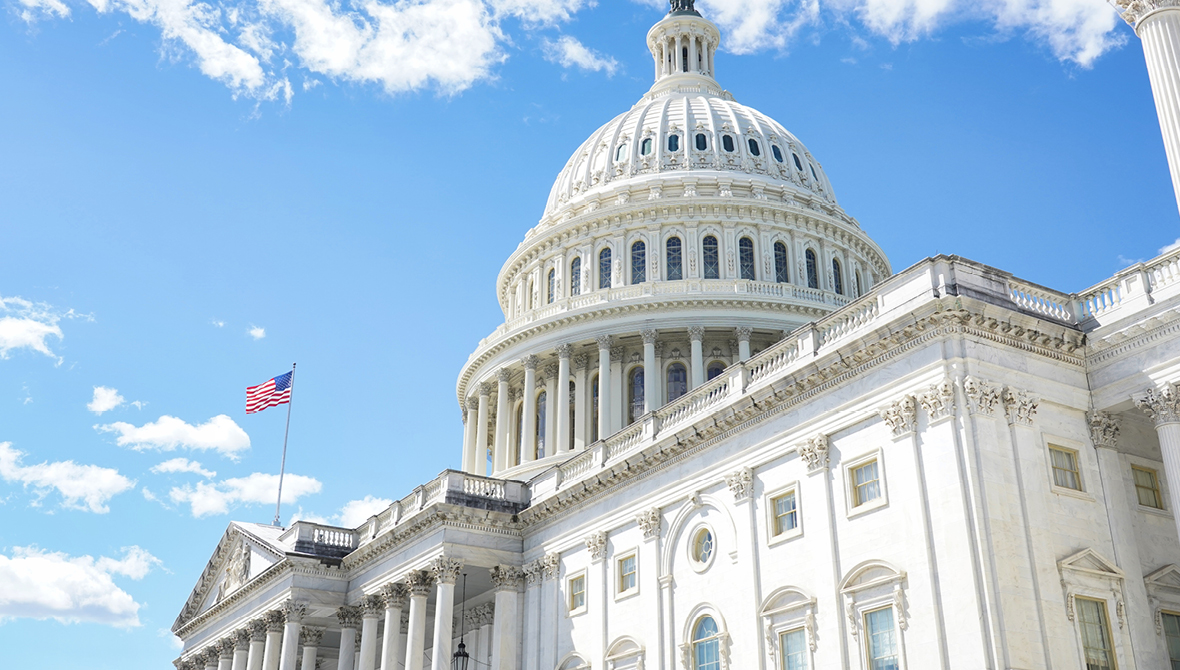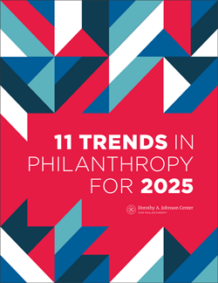Tax “Cliff” in 2025 Could Mean Major Change for Philanthropy and Nonprofits


 This article was first published in our 11 Trends in Philanthropy for 2025 report. Explore the full report here.
This article was first published in our 11 Trends in Philanthropy for 2025 report. Explore the full report here.
Want the latest trends, research, and more delivered right to your inbox? Subscribe to the Johnson Center email newsletter.
Though the American tradition of voluntary and charitable association predates the nation’s founding, formal recognition of a “tax-exempt sector” did not come until the Tariff Act of 1894 named specific types of organizations that could operate free from tax (Arnsberger et al., 2008). Additional laws and regulatory language slowly evolved1 until the Tax Reform Act of 1969. To this day, the 1969 act forms the basis of modern nonprofit organizational tax treatment (Arnsberger et al., 2008; Steuerle & Soskis, 2020).
Although debates about the taxation of nonprofits, the concentration of wealth, and the overlap between the nonprofit and for-profit sectors are not new (Moody, 2019), a confluence of major factors and a government-created tax “cliff” in 2025 has created momentum for a potential major overhaul of the charitable sector.
Between 1969 and today, Congress enacted two significant rewrites of the tax code — one in 1986, and one in 2017. Because of the expedited “reconciliation” process Congress used to enact the Tax Cuts and Jobs Act of 2017 (TCJA) (Tax Policy Center, 2024a, para. 2), many 2017 tax changes — such as individual income tax brackets, an increase in the individual standard deduction, changes to the pass-through business tax, and an increase in the estate tax exemption2 — are scheduled to sunset (expire) in 2025.
Neither the 1986 nor 2017 major tax code rewrites contained significant changes to nonprofit organizations; they had far more effects on individual and corporate tax rates and deductions. However, the 2025 TCJA sunset has become the focal point for three macro shifts that may bring large-scale change to the sector: increasing skepticism of institutions broadly and of philanthropy specifically, declining giving and volunteering rates, and the effects of TCJA itself.
Increasing Skepticism of Institutions Broadly and of Philanthropy Specifically
Government leaders, elected officials, the military, religious organizations, and businesses have all seen declines in trust over the last five decades and especially in the previous ten years (Brady & Kent, 2022; Gallup, 2024; Jones, 2022; Kennedy et al., 2022). Nonprofits and philanthropy have not been immune to the overall decline in trust, even though both score relatively high compared to other sectors (Independent Sector, 2024; Indiana University Lilly Family School of Philanthropy, 2023).
Skepticism is driving many philanthropists, members of Congress, and communities to push for new legislative action to drive change in how the sector operates. Our 2023 trend, “Policymakers are Paying Increasing Attention to Moving More Money Faster,” summarized efforts by philanthropists and Congress alike to spur or mandate increased charitable giving and grantmaking (Williams, 2023). Observers have noted that the Supreme Court’s 2010 Citizens United decision has led to increased scrutiny of wealthy donors and tax and campaign finance laws — and thus, nonprofits’ real or perceived impact on elections — by Democrats and Republicans alike (Lau, 2019; Rosenthal, 2022; Martin & Layton, 2024). These efforts have their roots in the decline of trust in institutions and critiques of philanthropy (Moody & Martin, 2020).
Declines in Giving and Volunteering
Longitudinal studies such as the Giving USA series have long shown that while the rate of individual giving is volatile from year to year, it has remained remarkably consistent as approximately 2.0% of disposable personal income over the past 40 years (Giving USA Foundation, 2024, p. 56).
However, this consistency on the surface masks a perceptible churning beneath. As Benjamin Soskis wrote earlier this year in The Shifting Landscape of American Generosity, this churning has a name: “dollars up, donors down” (p. 5). This phrase references a two-decade decline in the number of donors to charities of all kinds and the simultaneous increase in total dollars given. Efforts such as the Generosity Commission have been convened against this backdrop. Further, this broad decline in general giving from “everyday donors” explains why many philanthropic sector-based advocacy associations continue to support restoring items such as the charitable tax credit at both the federal and state levels.
Effects of TCJA itself
Multiple researchers in the last year have been able to analyze trendline changes in individual deductions and link them to studies of charitable giving:
Eric Zwick (2024), a professor of economics and finance at the University of Chicago, has called the Tax Policy Center’s recent conversation on the looming 2025 tax code rewrite the “Superbowl of Tax Law.” The challenge for philanthropy will be to navigate an overhaul of the tax code — only the second major rewrite in the last 40 years — while navigating the confluence of the historic cultural trends explored here. Several proposed reforms to the TCJA are already making the rounds in policy circles (Clausing & Sarin, 2023; Marr et al., 2024; York et al., 2024), and additional proposals are very likely to emerge as the Congressional committees take their preparatory work public with the entrance of the new session — and president — in January 2025.
While the charitable sector is not the primary reason for the rewrite, the mere presence of a ‘soup to nuts’ discussion required by the sunsetting of major provisions of the TCJA will quickly put philanthropy on the radar of budget-balancing committees. Whether the ensuing policy and tax code changes encourage or discourage additional philanthropy remains to be seen.
1The Revenue Act of 1909, for example, codified the concept of no private inurement; the Revenue Act of 1917 set the first individual income tax deduction for charitable contributions; and the Revenue Act of 1950 set limits on how nonprofit organizations could earn unrelated business income (Arnsberger et al., 2008).
2The Congressional Research Service has a good overview summary of the major provisions of TCJA that will expire in 2025 (Crandall-Hollick et al., 2023) https://crsreports.congress.gov/product/pdf/R/R47846.


Arnsberger, P., Ludlum, M., Riley, M., & Stanton, M. (2008). A history of the tax-exempt sector: An SOI perspective. https://www.irs.gov/pub/irs-soi/tehistory.pdf
Brady, H. E., & Kent, T. B. (2022, November 15). Fifty years of declining confidence & increasing polarization in trust in American institutions. Daedalus, 151(4), 43–66. https://doi.org/10.1162/daed_a_01943
Clausing, K., & Sarin, N. (2023, September 27). The coming fiscal cliff: A blueprint for tax reform in 2025. The Brookings Institution. https://www.brookings.edu/articles/the-coming-fiscal-cliff-a-blueprint-for-tax-reform-in-2025/
Crandall-Hollick, M. L., Marples, D. J., & McDermott, B. (2023, November 21). Reference table: Expiring provisions in the “Tax Cuts and Jobs Act” (TCJA, P.L. 115-97). Congressional Research Service. https://crsreports.congress.gov/product/pdf/R/R47846
Gallup. (2024). Confidence in institutions. https://news.gallup.com/poll/1597/Confidence-Institutions.aspx
Giving USA Foundation. (2024). Giving USA 2024: The annual report on philanthropy for the year 2023. Indiana University Lilly Family School of Philanthropy. https://www.givingusa.org
Han, X., Hungerman, D. M., & Ottoni-Wilhelm, M. (2024, July). Tax incentives for charitable giving: New findings from the TCJA (Working Paper 32737). National Bureau of Economic Research. https://doi.org/10.3386/w32737
How did the TCJA affect incentives for charitable giving? (2024, January). Tax Policy Center. Accessed November 2024. https://www.taxpolicycenter.org/briefing-book/how-did-tcja-affect-incentives-charitable-giving
Independent Sector. (2024). Trust in Nonprofits and Philanthropy. https://independentsector.org/resource/trust-in-civil-society/
Indiana University Lilly Family School of Philanthropy. (2023, April). What Americans think about philanthropy and nonprofits. https://scholarworks.indianapolis.iu.edu/server/api/core/bitstreams/b5904a8a-5081-42cd-bd44-56740b98fb67/content
Jones, J. (2022, July 5). Confidence in U.S. institutions down; Average at new low. Gallup. https://news.gallup.com/poll/394283/confidence-institutions-down-average-new-low.aspx
Kennedy, B., Tyson, A., & Funk, C. (2022, February 15). Americans’ trust in scientists, other groups declines. Pew Research Center. https://www.pewresearch.org/science/2022/02/15/americans-trust-in-scientists-other-groups-declines/
Lau, T. (2019, December 12). Citizens United explained. Brennan Center for Justice. https://www.brennancenter.org/our-work/research-reports/citizens-united-explained
Marr, C., Fenton, G., & Jacoby, S. (2024, March 21). Congress should revisit 2017 tax law’s trillion-dollar corporate rate cut in 2025. Center on Budget and Policy Priorities. https://www.cbpp.org/research/federal-tax/congress-should-revisit-2017-tax-laws-trillion-dollar-corporate-rate-cut-in
Martin, T., Layton, M. (2024, January 17). Donor anonymity is under the microscope. 11 trends in philanthropy for 2024. Dorothy A. Johnson Center for Philanthropy at Grand Valley State University. https://johnsoncenter.org/blog/donor-anonymity-is-under-the-microscope/
Moody, M. (2019, February 13). The boundaries are blurring between philanthropy and business. 11 trends in philanthropy for 2020. Dorothy A. Johnson Center for Philanthropy at Grand Valley State University. https://johnsoncenter.org/blog/the-boundaries-are-blurring-between-philanthropy-and-business/
Moody, M., & Martin, T. (2020, January 15). Increasing critiques of (big) philanthropy. 11 trends in philanthropy for 2020. Dorothy A. Johnson Center for Philanthropy at Grand Valley State University. https://johnsoncenter.org/blog/increasing-critiques-of-big-philanthropy/
Rosenthal, S. (2022, August 29). Congress could end tax breaks for gifts to non-profits with political agendas. Forbes. https://www.forbes.com/sites/stevenrosenthal/2022/08/29/congress-could-end-tax-breaks-for-gifts-to-non-profits-with-political-agendas/
Soskis, B. (2024). The shifting landscape of American generosity. The Generosity Commission. https://www.thegenerositycommission.org/wp-content/uploads/2024/07/Generosity-Commission_Landscape-Analysis_072424_Final.pdf
Steuerle, C. E., & Soskis, B. (2020, February 8). Taxes and foundations: A 50th anniversary overview. https://www.urban.org/sites/default/files/publication/103608/taxes-and-foundations-a-50th-anniversary-overview_3.pdf
Tax Policy Center. (2024a) What is reconciliation? https://www.taxpolicycenter.org/briefing-book/what-reconciliation
Tax Policy Center. (2024b). How did the TCJA affect incentives for charitable giving? The Tax Policy Briefing Book. https://taxpolicycenter.org/briefing-book/how-did-tcja-affect-incentives-charitable-giving
Williams, J. (2023). Policymakers are paying increasing attention to moving more money faster. 11 Trends in Philanthropy for 2023. Dorothy A. Johnson Center for Philanthropy at Grand Valley State University. https://johnsoncenter.org/blog/policymakers-are-paying-increasing-attention-to-moving-more-money-faster/
York, E., Durante, A., Li, H., Watson, G., & McBride, W. (2024, May 7). Options for navigating the 2025 Tax Cuts and Jobs Act Expirations. Tax Foundation. https://taxfoundation.org/research/all/federal/2025-tax-reform-options-tax-cuts-and-jobs-act/
Zwick, E. [Brookings Institution]. (2024, September 12). The Tax Cuts and Jobs Act of 2017: Lessons learned and the debate ahead [Video]. YouTube. https://www.youtube.com/live/bUStOBzpVAs?t=1695s